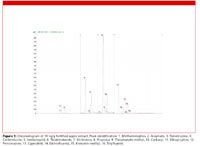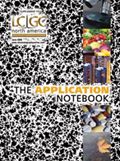Analysis of Pesticide Residues in Apples Using Agilent SampliQ QuEChERS AOAC Kit by LC–MS-MS Detection
The Application Notebook
Based on the QuEChERS AOAC Official Method 2007.01, sixteen pesticides were used for evaluating the performance of the Agilent's AOAC Buffered Extraction and SampliQ QuEChERS Dispersive SPE kits for General Fruits and Vegetables. Apple was selected as the fruit matrix. The pesticides are from the "representative pesticides" list (1). A method working well for these representative pesticides should work equally well for the other pesticides that are routinely monitored in multi-class, multi-residue methods. The compounds are from nine different pesticide classes: including acidic, basic, neutral, base-sensitive, and acid-labile pesticides. The selected pesticides are suitable for LC–MS-MS analysis. The MRLs of these pesticides have been set at 10 ng/g or higher (2–4).
Limian Zhao, David Schultz, and Joan Stevens, Agilent Technologies, Inc.
Based on the QuEChERS AOAC Official Method 2007.01, sixteen pesticides were used for evaluating the performance of the Agilent's AOAC Buffered Extraction and SampliQ QuEChERS Dispersive SPE kits for General Fruits and Vegetables. Apple was selected as the fruit matrix. The pesticides are from the "representative pesticides" list (1). A method working well for these representative pesticides should work equally well for the other pesticides that are routinely monitored in multi-class, multi-residue methods. The compounds are from nine different pesticide classes: including acidic, basic, neutral, base-sensitive, and acid-labile pesticides. The selected pesticides are suitable for LC–MS-MS analysis. The MRLs of these pesticides have been set at 10 ng/g or higher (2–4).
Experimental Instrument Conditions
Agilent 1200 HPLC with Diode Array Detector
Agilent 6410 Triple Quadrupole LC-ESI/MS/MS
Agilent SampliQ Buffered QuEChERS AOAC Extraction kits Agilent SampliQ QuEChERS AOAC Dispersive SPE kits: General Fruits and Vegetables
HPLC conditions:
Column: Agilent ZORBAX Eclipse Phenyl-Hexyl 150 mm x 3.0 mm, 3.5 µm, (p/n 959963-312)
Flow rate: 0.3 mL/min
Column Temperature: 30 °C
Injection volume: 10 µL
Mobile Phase: A: 5mM NH4OAc, pH 5.0 in 20:80 MeOH/H2O B: 5 mM NH4OAc, pH 5.0 in ACN. Gradient: 0-0.5 min (20% B), 0.5-8.0 min (20-100%B); Post run: 4 min Total cycle time: 17 min
MS conditions:
Positive mode
Gas Temperature: 350 °C
Gas Flow: 10 L/min
Nebulizer: 40 psi
Capillary: 4000 V
Extraction/Partitioning: 15 g (±0.05 g) homogenized sample were placed into a 50 mL centrifuge tube from the SampliQ QuEChERS Extraction kit. Tubes were capped, and vortexed; add 15 mL of 1% HAc in ACN. An Agilent AOAC Buffered Extraction packet containing 6 g of anhydrous MgSO4 and 1.5 g of anhydrous NaOAc, was added directly to the tubes, vigorously shaken and centrifuged.
Dispersive SPE Cleanup: An aliquot of the upper ACN layer was transferred into a SampliQ QuEChERS AOAC Dispersive SPE tubes, containing PSA and anhydrous MgSO4, capped, vortexed, and centrifuged. Aliquot of the extract was diluted 1:4, and analyzed by LC–MS-MS.
Results and Discussion
The unique design of Agilent's SampliQ QuEChERS kits, allows the whole procedure to be even faster, and easier, creating time, and labor savings, while ensuring consistency. An analyst can process 40–50 samples in just a few hours. Adding a food sample with a high percentage of water directly to the extraction salts containing MgSO4 may create an exothermic reaction that can affect analyte recovery. Agilent's SampliQ QuEChERS extraction salts and buffers are uniquely prepared in anhydrous packages. This allows addition AFTER adding solvent to the sample, as specified in the original QuEChERS methodology. The powerful selectivity of LC–MS-MS multiple reaction monitoring mode, indicate the blank apple extract did not contribute any interferences with the target compounds, Figure 1.

Figure 1
Conclusions
Agilent's QuEChERS AOAC Buffered Extraction and SampliQ AOAC Dispersive SPE kits for General Fruits and Vegetables provided a simple, fast, and effective method for the purification of representative pesticides in apple. The LOQs (5 ng/g or 5 ppb) of the pesticides were lower than their regulated MRLs. The recovery and reproducibility (RSD) for SampliQ QuEChERS were 95.4% and 4.3% (average), respectively. Notoriously base-sensitive pesticides such as Dichlorfluanid and Tolyfluanid showed excellent recoveries and RSDs; even an acid-labile pesticide, Pymetrozine, showed acceptable recovery and RSD. The Agilent SampliQ QuEChERS AOAC Extraction and Dispersive kits for General Fruits and Vegetables can be used for other pesticides in other similar fruit matrices.
References
(1) S. J. Lehotay, et al; "Use of Buffering and Other Means to Improve Results of Problematic Pesticides in a Fast and Easy Method for Residue Analysis of Fruits and Vegetables, J. AOAC Int., 2005, 88, 615-629.
(2) M. Anastassiades, S. J. Lehotay, "Fast and Easy Multiresidue Method Employment Acetonitrile Extraction/Partitioning and 'Dispersive Solid-Phase Extraction' for the Determination of Pesticide Residues in Produce," 2003, 86, 412–431.
(3) S. J. Lehotay, et. al.; "Determination of Pesticide Residues in Foods by Acetonitrile Extraction and Partitioning with Magnesium Sulfate: Collaborative Study," J. AOAC Int., 2007, 90, 485–520.
(4) http://sitem.herts.ac.uk/aeru/footprint/en/index.htm.
(5) http://www.m5.ws001.squarestart.ne.jp/foundation/search.html.
(6) http://www.mrldatabase.com/?selectvetdrug=0.

Agilent Technologies, Inc.
2850 Centerville Road, Wilmington DE 19808
tel. (800)227-9770; fax (866)422-5571
Website: www.agilent.com
















